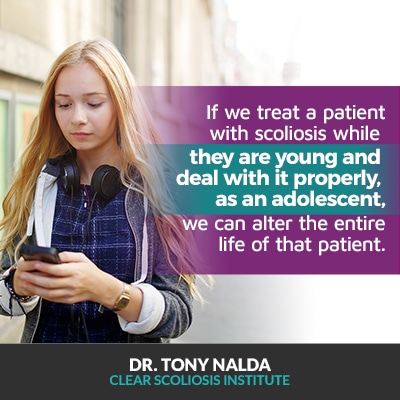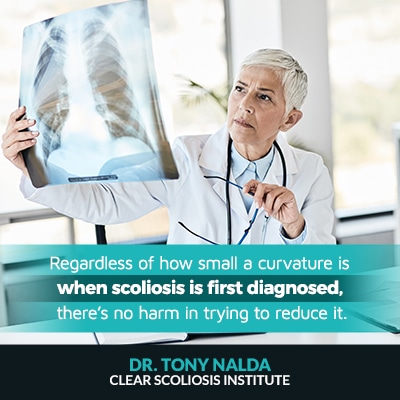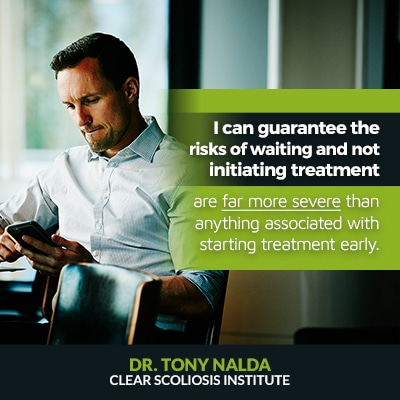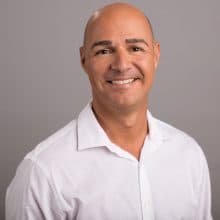
When we see scoliosis in children, we take their treatment very seriously. While treating children with scoliosis is where we can make the biggest impact in terms of long-term improvement, it’s also the age group at the highest risk of rapid progression.
When we think of scoliosis, we most often think of children developing the condition in their adolescent years when they’re going through growth spurts. Even though that’s the most common association with scoliosis, it’s interesting that the largest age group population with scoliosis is the elderly.
This is because not only does that age group include adults who’ve recently developed the condition, you also have the adults who were adolescents with the condition but didn’t discover it until adulthood.
So in terms of actual numbers, the elderly represent the most common population with scoliosis; however, it’s in the treatment of children with scoliosis where we can make the biggest impact.
Here at the CLEAR Scoliosis Institute, treating children with scoliosis is something we approach very seriously. If we treat a patient with scoliosis while they are young and deal with it properly, as an adolescent, we can alter the entire life of that patient.

The flip side of that is that children with scoliosis are also facing the greatest chances of rapid progression due to the unpredictable nature of growth spurts and the fact that growth is the number-one risk factor for progression.
One of the biggest factors that affect the form a child’s scoliosis will take is the treatment approach that’s chosen.
What can end up happening is a child with a 10-, 15-, or 20-degree curve will see their pediatrician or orthopedist, and the parents or caregivers are told that it’s a mild case, not to worry, and to watch and wait.
A lot of times, it’s not explained to them that as that child starts to grow, the scoliosis has a higher risk of progression. Most often, they’re only told to return for assessment within a fixed time period. They can even be told not to return for an entire year.
In that year, a lot can happen. There could be significant growth and developmental changes that can cause the curve to progress rapidly. What bothers me the most about that is the valuable potential treatment time that’s been wasted. When it comes to getting a reduction in a child, timing is crucial.
This is why scoliosis in children has both the best chances for successful treatment, and the highest chance of rapid progression; where a child lands in those potential outcomes depends upon a number of factors, one of the biggest being the form of treatment that’s chosen.
If observation is the chosen treatment path, it has to be very specific and that child will need to be evaluated very regularly. Every time a child goes through a growth spurt, that curve can progress.
If you are the parent or caregiver of a child with scoliosis and you are choosing the traditional treatment path of observation, you have to really watch the child for signs of a growth spurt. The most obvious signs to watch for are outgrowing clothes. For someone who sees a child every day, sudden growth is not so easy to spot, but looking at how their clothes fit is a good way to gauge if they are growing and at what rate.
Here at CLEAR, we have a very different approach to treating scoliosis in children. When we see a child with scoliosis and the chosen path is observation, we don’t say, “Come back in a year and let’s evaluate.” What we do say is for them to come back either within a certain time period, or when growth is occurring: whichever happens first.
This is because if a child walks out of our office and doesn’t return for six months or a year, in that time, it’s entirely possible for their curve to progress 30 or 40 degrees.

What I like to remind people is that every large curve has one thing in common: they were all smaller at one point. Therefore, the big question becomes what type of treatment to opt for and how long to wait before starting treatment.
Here at CLEAR, every child we see with a curvature gets our recommendation to start treatment immediately. Our goal is always to achieve a reduction, and we know that the best chances of doing so are by starting treatment early on before the curve gets larger and harder to treat. Regardless of how small a curvature is when scoliosis is first diagnosed, there’s no harm in trying to reduce it.
Let’s look at two different treatment-outcome scenarios: the first is a child who comes to us with a 20-degree curve. We work to reduce it and succeed, and now, that curve is only 10 degrees - that’s a successful outcome.
Let’s say that the 20-degree curve doesn’t reduce with treatment but stays the same. In that scenario, there’s the possibility that without treatment, it might have progressed, but even in the event that it wouldn’t have progressed, no harm was done by starting treatment early on; however, leaving that curve untreated, having a growth spurt hit, and having that curve progress to 30, 40, or 50 degrees can be very harmful.
At that point, the condition we’re dealing with has become much more severe. While we see no harm in attempting to reduce a curve as soon as we diagnose scoliosis, we see a lot of harm in simply observing while a condition is left to progress unimpeded.
When it comes to the different treatment paths, while the traditional approach might seem less invasive as it involves a lot of passive observation, that passive observation puts patients at a higher risk for progression and a subsequent recommendation for spinal-fusion surgery.

Our functional chiropractic-centered approach is considered noninvasive because it's extremely low risk, meaning that even if treatment doesn’t result in a reduction, there's no harm done.
When it comes to spinal-fusion surgery, it makes sense that people would want to wait until it's deemed absolutely necessary because it’s so invasive and carries a high risk of potential complications. Once a patient reaches a 50-degree curve, in an orthopedic mindset, that surgery is going to be the number-one treatment in terms of reducing the patient’s curve.
I believe that’s why the model for watching and waiting is so firmly entrenched. Waiting till 25 or 45 degrees to wear a brace doesn’t reduce a curve, but holds it in position, and for a curvature of 45+, surgery can be seen as the best treatment option because nothing else was tried sooner.
When it comes to treating scoliosis in children and children with scoliosis, our CLEAR team of doctors certified in scoliosis-specific chiropractic treatment choose not to wait. As our treatment approach doesn’t pose any potential harm or risk factors for our patients, we believe in starting treatment as soon as possible.
Especially as scoliosis in children is where we can make the biggest impact in the lives of our patients and offer the greatest long-term outcomes, it makes perfect sense to be proactive in our approach.
It’s also much more cost-effective to start treating a child’s scoliosis early on. The smaller the curve, the less treatment a child is likely to need and the faster that treatment is likely to work. For patients who end up waiting till the point that spinal-fusion surgery is recommended, that cost is high.
Often, when we see children less than 11 years of age come in with a 20-degree curve, we’re able to resolve the case, meaning we reduce the curve so low we don’t need to treat them anymore. In some cases, we can reduce the curve to under 10 degrees, and then we monitor them closely, especially during times of growth, and watch for any signs of progression.
We have many cases like that that we’re able to resolve, but once a patient reaches that 40-, 50-degree mark, we know we’re not resolving that case; we’re likely treating them until they stop growing.
Also listen to our related podcast episode: Scoliosis in Children

While there are different treatment approaches available, I caution parents and caregivers to do their due diligence in researching the potential risks of starting treatment early versus watching and waiting. I can guarantee the risks of waiting and not initiating treatment are far more severe than anything associated with starting effective conservative treatment early.
Here at the CLEAR Scoliosis Institute, we want to give children with scoliosis the best possible chance of a happy, complication-free life, and our proactive chiropractic-centered treatment approach does just that.

CLEAR provides a unique and innovative way of understanding scoliosis. Sign up to receive facts and information you won’t find anywhere else.

Thanks for the great blog Dr. Tony.
Worth to read. So much information.